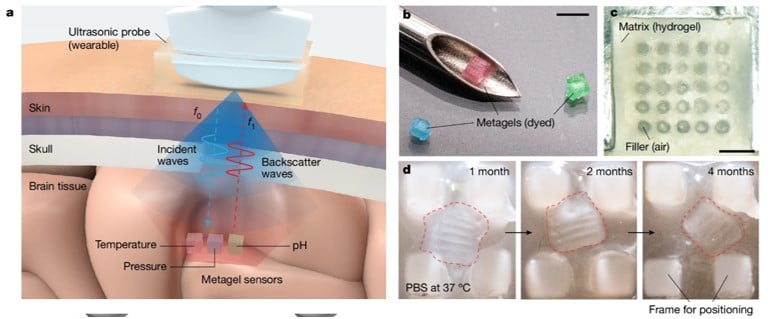Breakthrough in Intracranial Monitoring
Imagine a future where brain injuries and diseases can be monitored accurately and continuously without the need for cumbersome wired probes and invasive surgeries. That future is now one step closer to reality, thanks to the pioneering work led by Professor Chen Xiaodong from the School of Materials Science and Engineering, Nanyang Technological University, Singapore (NTU Singapore).
In a seminal study published in Nature, Professor Chen, the President’s Chair in Materials Science and Engineering at NTU Singapore, and his international team of researchers from Huazhong University of Science and Technology have developed an injectable, biodegradable wireless sensor for monitoring multiple parameters within the brain. Dubbed the “metagel”, this tiny 2x2x2 mm3 cube is set to transform how we diagnose and manage neurological conditions.
 a) Diagram showing metagels as wireless intracranial physiology sensors using ultrasound reflection; b) Photograph of metagel samples and puncture needle for delivery; c) Microscopy image showing metagel structure; d) Photographs showing a metagel degrading following 1 month in PBS solution at 37 °C; dashed line delineates the shape of the metagel. (Nature 630, 84-90 (2024)) |
The metagel is composed of a clever combination of biodegradable hydrogels and periodically arranged air columns. When implanted into the brain through a minimally invasive injection, the metagel deforms in response to the intracranial physiological environment. These deformations lead to shifts in the peak frequency of reflected ultrasound waves, which can be measured wirelessly by an external ultrasound probe up to 10 cm deep. This ensures reliable data transmission even from deeper intracranial locations.
What sets the metagel apart is its ability to monitor multiple crucial parameters simultaneously, including intracranial pressure, temperature, pH, and blood flow. Until now, such comprehensive monitoring required the use of invasive wired probes that carried risks of infection, restricted patient mobility, and necessitated surgical removal.
In contrast, the metagel is fully biodegradable and harmlessly dissolves within 18 weeks after implantation, negating the need for a second surgery to remove the implant. Animal experiments conducted on rats and pigs have demonstrated that the metagel’s multiparametric sensing performance is com-parable to conventional wired clinical benchmarks. The sensor proved to be biocompatible, providing stable intracranial monitoring for over 3-4 weeks before beginning to degrade.
Professor Chen, a leading figure in soft bioelectronics and nanotechnology, expressed excitement about the metal’s potential impact: “Our metagel sensor represents a significant leap forward in intracranial monitoring technology. By providing real-time, multimodal data on brain health, we hope to empower clinicians to detect neurological issues earlier and intervene more effectively. This international collaboration has yielded a truly transformative technology that could reshape the way we manage brain injuries and disorders.”
This research breakthrough highlights NTU Singapore’s commitment to pushing the boundaries of materials science and engineering to address critical healthcare challenges. The metagel platform opens up exciting possibilities for developing advanced ultrasonic implantable sensors that could revolutionise the management of brain injuries and neurological disorders.
Research Article:
“Injectable ultrasonic sensor for wireless monitoring of intracranial signals”, Nature, 630, 84-90 (2024). DOI: https://doi.org/10.1038/s41586-024-07334-y







